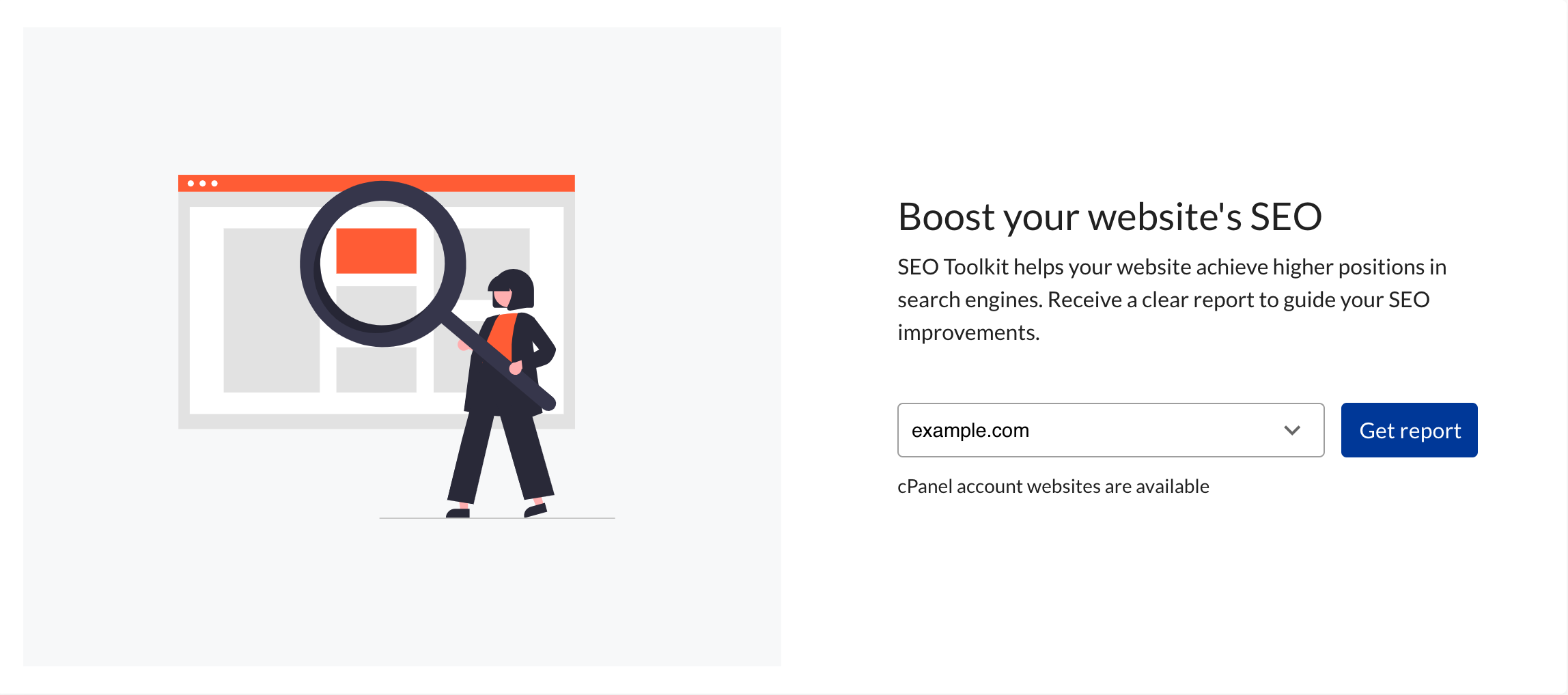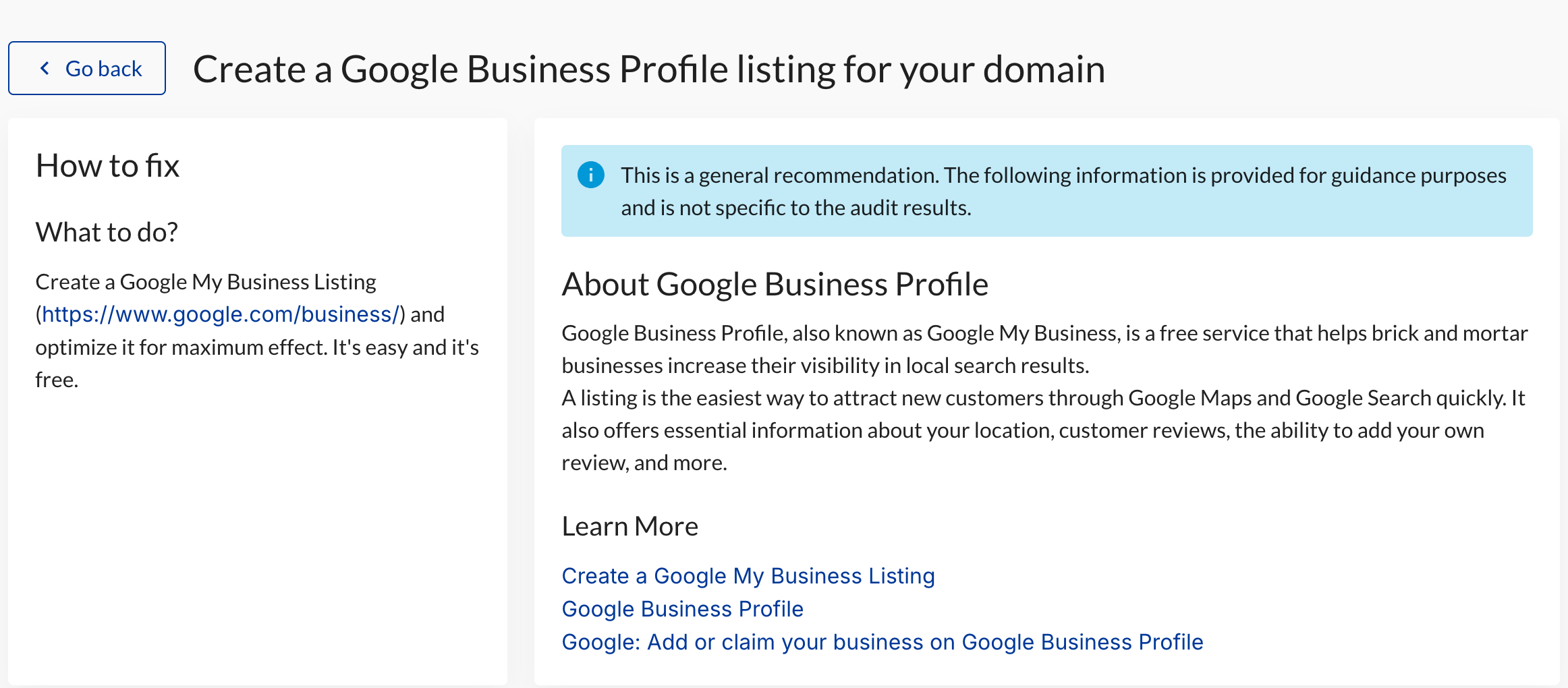Search Engine Optimization
Last modified: 2025 August 21
Looking for this interface?
Your hosting provider can enable or disable this interface in WHM's Feature Manager interface (WHM >> Home >> Packages >> Feature Manager).
WebPros International, LLC currently provides this feature in a limited release, with plans to expand its availability in future updates.
Overview
The Search Engine Optimization interface (cPanel » Home » Domains » Search Engine Optimization), also accessible from the Main Menu, allows you to audit your websites for search engine optimization. Search engine optimization (SEO) refers to the practice of organizing website structure and content to make it easy for search engines like Google® to identify the site’s purpose. This helps search engines deliver your website content to users who search for terms related to the site’s purpose - for example, affordable microscope store.
- You must have a website with a valid IP address that you can manage. For more information about how to create a website with cPanel & WHM, read our Create a Website documentation.
- You cannot use Search Engine Optimization with a temporary domain. If you have a temporary domain and want to use Search Engine Optimization, contact your hosting provider to replace the temporary domain with a registered domain.
Run your first audit
To use the Search Engine Optimization interface (cPanel » Home » Domains » Search Engine Optimization), you must run at least one audit. To do so, select the first domain whose SEO you want to audit in the Boost your website’s SEO menu, then click Get Report:

A Quick SEO Audit will begin, and your domain’s audit report will open.
Register for the Full SEO Audit
You can register for the Full SEO Audit by completing the unlimited audit sign-up process.
When you click Sign up for free in the Unlock unlimited audits menu in your domain audit report, the Sign up text box will appear. Enter your email and click Continue to start the sign-up process to receive unlimited Full SEO Audits.
You will receive a sign-up email with a security code, and the Verify your email section will appear. Enter your security code in the Security code text box and click Finish sign up to finish signing up and unlock unlimited audits.
You will return to your domain’s audit report.
SEO audit types
The following audit types are available with Search Engine Optimization:
| Audit type | Functionality |
|---|---|
| Quick SEO Audit |
|
| Full SEO Audit |
|
Issue priorities
The Search Engine Optimization tool ranks SEO issues with a priority level to make it clear which issues pose the most risk to your websites’ search engine rankings. The priority levels are as follows:
| Priority level | Description |
|---|---|
| Low | This issue could have minor impacts on your website’s search engine ranking.
Important:
Although low-priority issues do not individually affect search engine rankings as much as higher-priority issues, multiple low-priority issues can add up to have a significant negative impact on search engine rankings. |
| Medium | This issue could decrease your search engine ranking. |
| High | This issue will seriously decrease your search engine ranking. |
The domain audit report
The domain audit report contains the following items:
- Add website — Click this to open the Add a website menu.
- Account Settings — Click this to open the Account Settings section.
- The All issues tab — This tab contains a summary of all the SEO issues your audit identified.
- The Page-based issue list tab — This tab contains a list of the SEO issues your audit identified that belong to a specific webpage.
- A screenshot from your domain
- Your website’s audit score
- The Your SEO Audit report is ready section. — This section includes the domain audited, the audit type and date, and the Run Quick Audit and Run Full Audit buttons. Click one of these options to rerun an audit at any time, even if you have not signed up for unlimited audits.
If you have not signed up for unlimited audits, the domain audit report also contains an additional sign-up menu, the Unlock unlimited audits menu. Click Sign up for free to begin the unlimited audit sign-up process.
All issues
The All issues tab of your domain audit report contains your overall SEO audit report with a summary of the Found issues list. You can sort the issues in this list with the following buttons, where All is the default selection:

You also can select the High priority, Medium priority, or Low priority checkboxes to filter the SEO audit results that you see.
The filter checkboxes are only available when you run a full audit.
Resolve issues
You can click the Expand icon ( ) next to any item in the report to open its specific recommendations for how to resolve the issue. Some recommendations are general, while some are specific to your domain.
) next to any item in the report to open its specific recommendations for how to resolve the issue. Some recommendations are general, while some are specific to your domain.
The recommendation report contains two tabs, which provide an explanation for each issue and a recommendation about how to fix it, as in the following example:
 .
.
- The How to fix tab — This tab provides a brief explanation of the issue and a recommendation to fix it.
- The Help and information tab — This tab provides extended information. The Learn More links contain more information about the recommendation, including tutorials about how to implement the suggested change.
Page-based issue list
The page-based issue list contains a list of SEO checks sorted by the page on your website they affect. It also includes a 2D Rank, which assigns a score from 1 to 100 to the page, based on its importance to your site.
The Pages section only displays issues that exist on the specific pages listed. It does not list issues that apply to your website as a whole.
All websites
The All websites section contains the current websites table and the Add a website menu.
The Add a website menu
To add a website to the current websites table, select it in the Add a website menu, then click Add website. The website will appear in the current websites table.
The current websites table
The current websites table lists all the websites that you can currently audit. The websites are listed with the following information:
| Section | Description |
|---|---|
| Domain | The website’s domain. |
| Icon |
|
| Audit Result | Whether the audit successfully completed, as follows:
|
| Audit Date | The day the audit was attempted. |
| Score | A completed audit’s score. This score describes how easy a website’s content and structure is for search engines to process. |
Each entry in the table also allows you perform the following actions:
| Action | Description |
|---|---|
| Run Quick Audit | Run a quick audit of your website. |
| Run Full Audit | Run a full audit of your website. |
| Delete | Click the trash can icon ( |
| Open report | Entries with a successful audit contain a caret icon ( ) that opens the domain audit report. ) that opens the domain audit report. |
Click Which audit to choose? to open a menu that compares your available audit types.
Account Settings
In this section, you can add a website to Search Engine Optimization or remove all your websites from Search Engine Optimization.
Click Add website to open the Add a website menu.
Click Delete the account to permanently delete your SEO audit reports and remove all the websites from the current websites table. This action will not affect your cPanel account or websites.